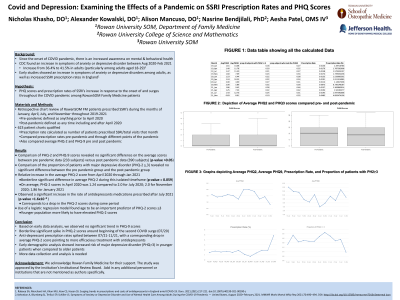Back

Clinical: General Topics
COVID and Depression: Examining the Effects of a Pandemic on SSRI Prescriptions rates and PHQ scores
Friday, March 31, 2023
12:00 PM East Coast USA Time

- NK
Nicholas A. Khasho, DO (he/him/his)
Family Medicine PGY3
RowanSOM
Maple Shade, New Jersey, United States
Presenting Author(s)
Background and Hypothesis: Since the onset of the COVID pandemic there is an increased awareness on mental and behavioral health. Early studies showed an increase in symptoms of anxiety or depressive disorders among adults, as well as increased SSRI prescription rates in England. To better understand if similar trends apply to Rowan SOM family medicine practice, this study observed and compared antidepressant prescription rates and PHQ-2/PHQ-9 scores from pre-pandemic periods to pandemic peak timelines, with close attention during surges.
Methods: A retrospective chart review of RowanSOM FM patients was conducted to establish average SSRI/SNRI prescription rates and collect PHQ-2 and PHQ-9 scores for patients during the months of January, April, July, and November throughout 2019-2021. Using this data along with patient demographics, prescription rates and PHQ scores were compared to monitor patients’ mental health through the pandemic.
Results: During the months listed above there were a total of 34,618 patient visits, of which 623 patients were prescribed SSRI’s or SNRI’s (excluding follow ups). Baseline prescription rates in 2019 were 1.49% (01/19), 1.82% (04/19), 1.68% (07/19), and 1.81% (11/19). Prescription rates were lowest in 11/20 at 0.7% and peaked in 07/21 at 4.8% (P-value=1.6x10¬ -9). Data analysis using two tailed t-tests showed average PHQ-2 scores spiked from 1.4 in 04/20 to an average of 1.8 in 07/20-01/21 (p-value=0.059). Use of a logistic regression model to predict likelihood of PHQ-2 > 3 based on demographics found younger patients more likely to have PHQ-2>3 when compared to older patients (p-value=0.01)
Conclusion: Based on early data analysis, we observed no significant trend in PHQ-9 scores, however there was a borderline significant spike in PHQ-2 scores around the beginning of the second COVID surge (07/20). Anti-depressant prescription rates spiked between 07/21-11/21 with a corresponding drop in average PHQ-2 score pointing to more efficacious treatment with antidepressants. Early demographic analysis showed increased risk of major depressive disorder (PHQ>3) in younger patients when compared to older patients. More data and analysis is needed.
Acknowledgement of Research Study Sponsors and IRB: This study was approved by Rowan’s Institutional Review Board.
Methods: A retrospective chart review of RowanSOM FM patients was conducted to establish average SSRI/SNRI prescription rates and collect PHQ-2 and PHQ-9 scores for patients during the months of January, April, July, and November throughout 2019-2021. Using this data along with patient demographics, prescription rates and PHQ scores were compared to monitor patients’ mental health through the pandemic.
Results: During the months listed above there were a total of 34,618 patient visits, of which 623 patients were prescribed SSRI’s or SNRI’s (excluding follow ups). Baseline prescription rates in 2019 were 1.49% (01/19), 1.82% (04/19), 1.68% (07/19), and 1.81% (11/19). Prescription rates were lowest in 11/20 at 0.7% and peaked in 07/21 at 4.8% (P-value=1.6x10¬ -9). Data analysis using two tailed t-tests showed average PHQ-2 scores spiked from 1.4 in 04/20 to an average of 1.8 in 07/20-01/21 (p-value=0.059). Use of a logistic regression model to predict likelihood of PHQ-2 > 3 based on demographics found younger patients more likely to have PHQ-2>3 when compared to older patients (p-value=0.01)
Conclusion: Based on early data analysis, we observed no significant trend in PHQ-9 scores, however there was a borderline significant spike in PHQ-2 scores around the beginning of the second COVID surge (07/20). Anti-depressant prescription rates spiked between 07/21-11/21 with a corresponding drop in average PHQ-2 score pointing to more efficacious treatment with antidepressants. Early demographic analysis showed increased risk of major depressive disorder (PHQ>3) in younger patients when compared to older patients. More data and analysis is needed.
Acknowledgement of Research Study Sponsors and IRB: This study was approved by Rowan’s Institutional Review Board.
